The idea seemed preposterous: Three people, one medium-sized dog, two sets of golf clubs (minus one of the bags), three duffel bags and all the usual paraphernalia – including 10 pairs of shoes(?) – required for a long weekend at the lake. But how to stuff all that stuff in a subcompact? Yes, we knew there would be complaints, but we undertake this research for you, the loyal readers.
Somehow, we crammed it all in. Looked like a clown car with all the people and stuff popping out of this Ford Fiesta upon arrival, but it illustrates a point: It is possible to travel comfortably in a subcompact. We even had room to take home a couple of gifts and knick knacks purchased at the annual craft fair.
An added bonus was superb mileage: Over a week spent with the Fiesta, mostly traveling on rural two lanes, we averaged 39 mpg. This thing doesn’t so much sip fuel, it dabs a rag in it and wrings out every last drop.
Following a groundbreaking social media campaign, it seems that Ford has been telling us about the Fiesta for a long time. Now that it is here, it’s easy to see what all the fuss was about.
The Fiesta has fun styling details, nifty interior touches and some clever features. It’s entertaining and easy to drive.
The Fiesta is available in two basic flavors, four-door sedan and five-door hatchback. Ford higherups apparently had to be convinced that it should offer the hatchback in the U.S. They had so much trouble moving hatchback versions of the original Ford Focus that they now only offer that car as four- and two-door sedans only.
Just a thought: Maybe if Ford didn’t charge a $800 premium for the smaller – by 13 inches – hatchback, it wouldn’t have so much trouble moving them. And the hatchback doesn’t even come in the base S trim. Yes, I know, the hatchback has an extra door and all of the associated engineering, etc., but smaller often means cheaper. OK, I’ll get off the soapbox now.
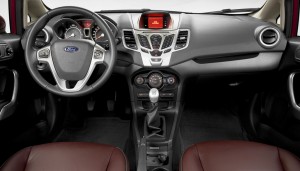
The Fiesta's cool angles and shapes continue inside. Unfortunately, the infotainment system does not work as well as some of Ford's best products.
One of the coolest features of the Fiesta is its automated manual six-speed transmission. It was so smooth, I thought I had remembered wrong that a regular slushbox automatic wasn’t even an option in this car. It starts off from lights smoothly, shifts quickly and with little fuss. Expect to see more of these transmissions in the future because they are more efficient than typical automatics with their power-robbing torque converters.
As much as we enjoyed the transmission, there are a few criticisms. Oddly, it was sometimes reluctant to offer a downshift when requested, a surprise because the computer can shift so much more quickly than a driver with a clutch pedal and gearshift. Also, it would be even more fun if it offered manumatic shifting.
There are two reasons for the lack of manumatic shifting. First is the obvious one, cost. Second is the computer will always do a better job choosing when to shift than a human when the goal is efficiency. And this car is about big-time fuel economy.
On that count, Ford did very well. It’s rated at 30 city and 40 highway. Want better fuel economy? Buy a hybrid, but don’t expect to pay Fiesta prices for a new one.
The Fiesta is powered by a 1.6-liter four cylinder making 120 horsepower and 112 pound-feet of torque. It may not sound like much, but the little engine has less than 2,600 pounds to drag around via its front wheels.
Acceleration is rather tepid, but the engine revs smoothly.
The electric-assist power steering is sharp and has good feedback. The car handles pavement imperfections superbly. There is no torque steer.
Complaints? Of course, there are a couple. First, the rear of the car seems floaty at freeway speeds, particularly when unloaded. Not surprising for a car of this size, crosswinds tend to push it around a bit.
But the biggest criticism revolves around the Fiesta’s convoluted infotainment system. The Fiesta was largely designed by Ford’s European group and it shows through in the entertainment system. For some reason, Europeans must be willing to accept arcane menus and difficut-to-understand operations. They must enjoy the novelty of buttons that would seem to be designed to perform a task, but don’t. For example, after finding my way to one particular screen, I decided to just go back to the radio, believing that pushing the “radio” button would take me there. But it wouldn’t.
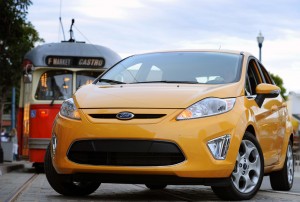
Fuel mileage is the Fiesta's big calling card and on that count it does well. We recorded 39 mpg during a week with the Fiesta.
And why, with 10 buttons on the steering wheel, do none of them control the radio volume? Even the Sync voice button is relegated to the turn signal stalk.
Hey Ford: Tell the European office that you’re taking control of all infotainment design and functionality. Cars like the new Edge show that you’re good at it. Don’t worry, the Euros will get used to entertainment systems that make sense.
Fiestas start at $13,995 (including destination), for a base S sedan with a five-speed manual transmission. The Fiesta Hatch SE – the lowest-priced hatchback available – tested here starts at $15,795. With upgraded stereo, automatic trans, ambient lighting package, Sirius satellite radio, heated front seats and the Super Fuel Economy Package (P195/60 15-inch tires, cruise control, painted aluminum wheels), the as-tested price rang the cash register to the tune of $18,820.
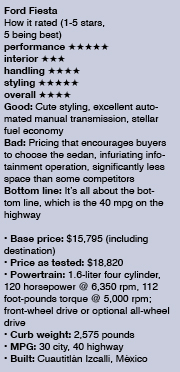 Typical of cars in this price range, there is no center armrest, which makes long drives less than comfortable because there is no where to rest your right elbow. Surprisingly, Ford doesn’t even list one as an accessory, which is not typical.
Typical of cars in this price range, there is no center armrest, which makes long drives less than comfortable because there is no where to rest your right elbow. Surprisingly, Ford doesn’t even list one as an accessory, which is not typical.
The seats are Euro stiff, but they’re comfortable. There’s plenty of lateral support for the cornering ability of the car.
The upholstery in the test car was black with cool blue stitching and accents. The oversize rear headrests require the front seats to be moved forward to lower the rear seats. Also, those massive headrests block rearward vision, although the center headrests slides into the seatback.
The Fiesta isn’t very wide and those who are a little wide in the beam will find that some parts hang off the sides of the seats a bit. Rear seat riders will find deeply scalloped front seatbacks and decent headroom. Legroom is limited by cooperation from those in the front seats.
There is a surprising 15.4 cubic feet of space behind the second row. Fold the rear seats and that number climbs to a unimpressive 26 cubes. The load floor is not flat.
Shockingly, the Honda Fit, which is just 1.5 inches longer, squeezes 21 cubic feet behind its rear seats and a station-wagon-like 57 cubes with the rear seats folded.
So if storage space is a priority, the Fiesta is not the best choice.
But there’s a ton of safety technology packed in here including seven airbags, traction control and stability control.
While this might not be in keeping with the Fiesta’s fuel-efficient mission, a sport-minded model might be a fun addition to the Fiesta lineup. Firm up the suspension, give it better brakes and some paddle shifters for that cool transmission and it could be a lot of fun. Extra horsepower is always welcome, but it isn’t entirely necessary to increase the Fiesta’s fun quotient.
Fewer trips to the gas station are the Fiesta’s calling card. And that’s the main reason Ford will see a steady stream of customers who are interested in its new little fuel dabber.

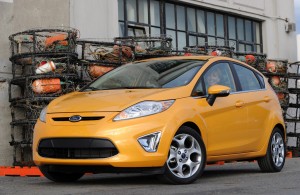
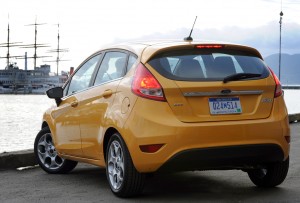
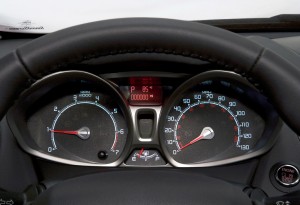
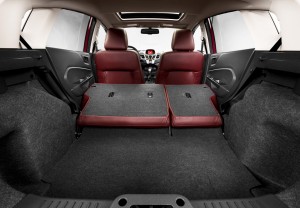
I agree completely on the volume buttons – however, they removed them when they brought it over to the States. The European version has them, and they were the two most-used buttons when I was driving one.
That seems to have been an odd decision, no question. Other than the button on cars with Bluetooth to hang up a call, volume is the button(s) I use most.
Paul E.
Yeah, they added a “function” button on top of the bluetooth button, which is unnecessary. The middle function button could just hang up the phone when in phone mode. Theoretically, they could reprogram the buttons to control volume if they wanted (or wanted to let us). There’s a data port that can do USB updates.